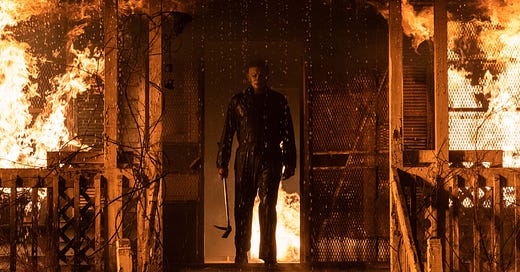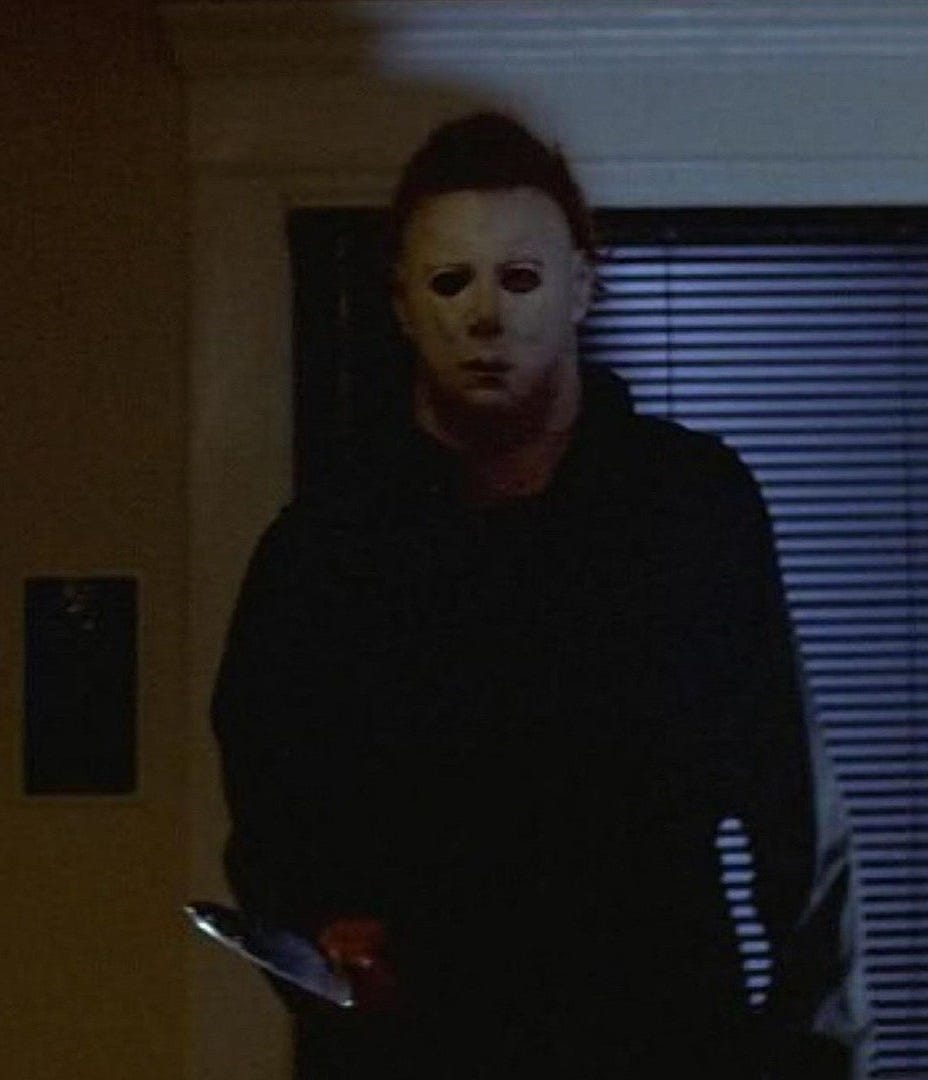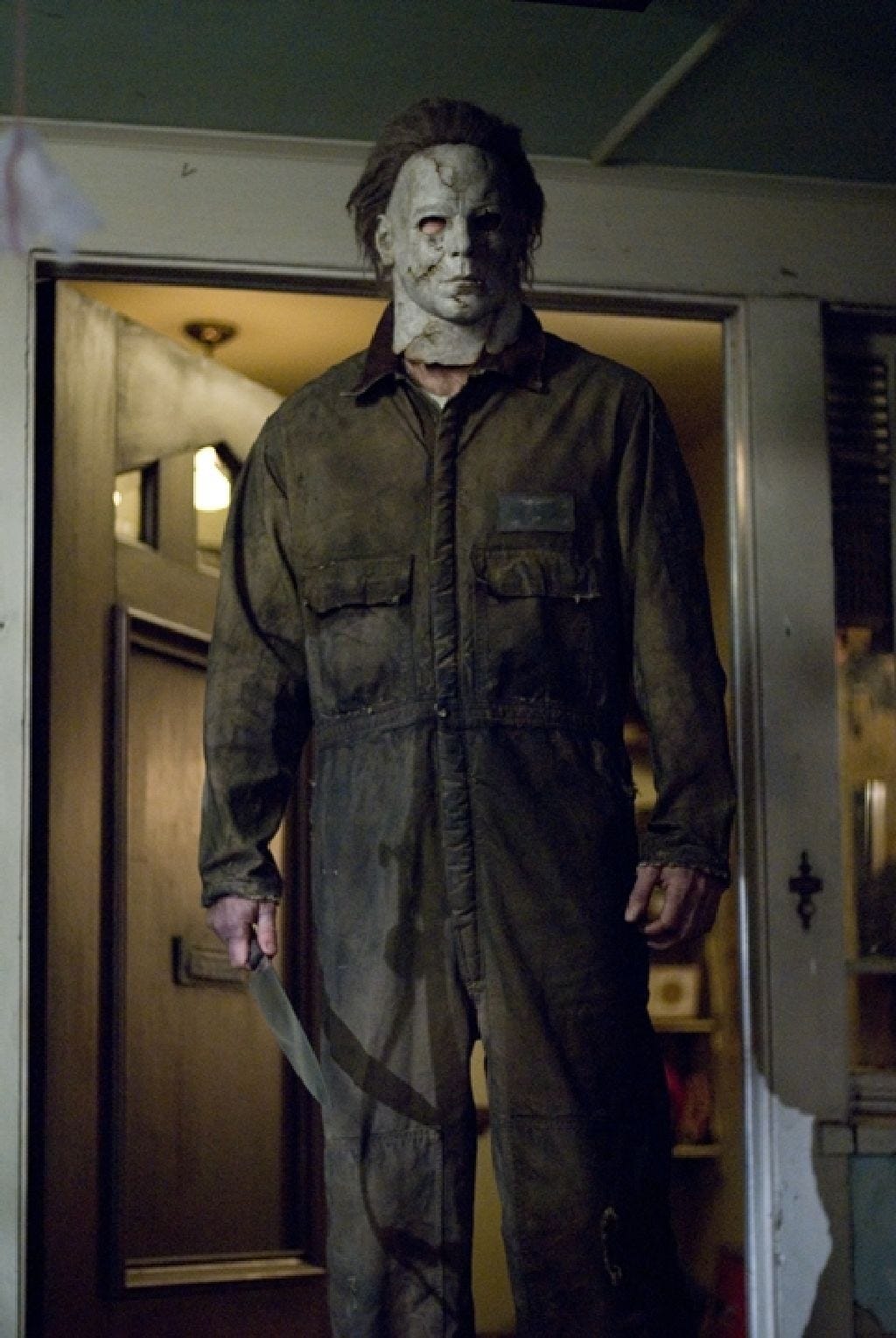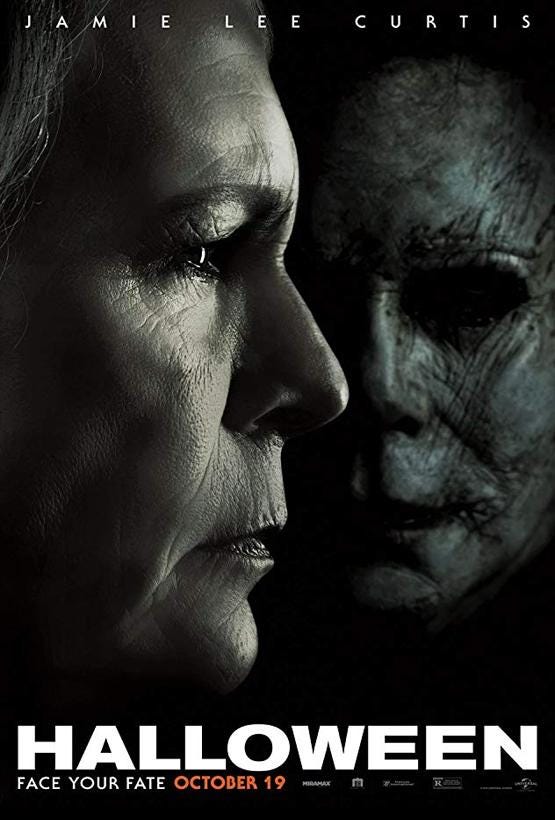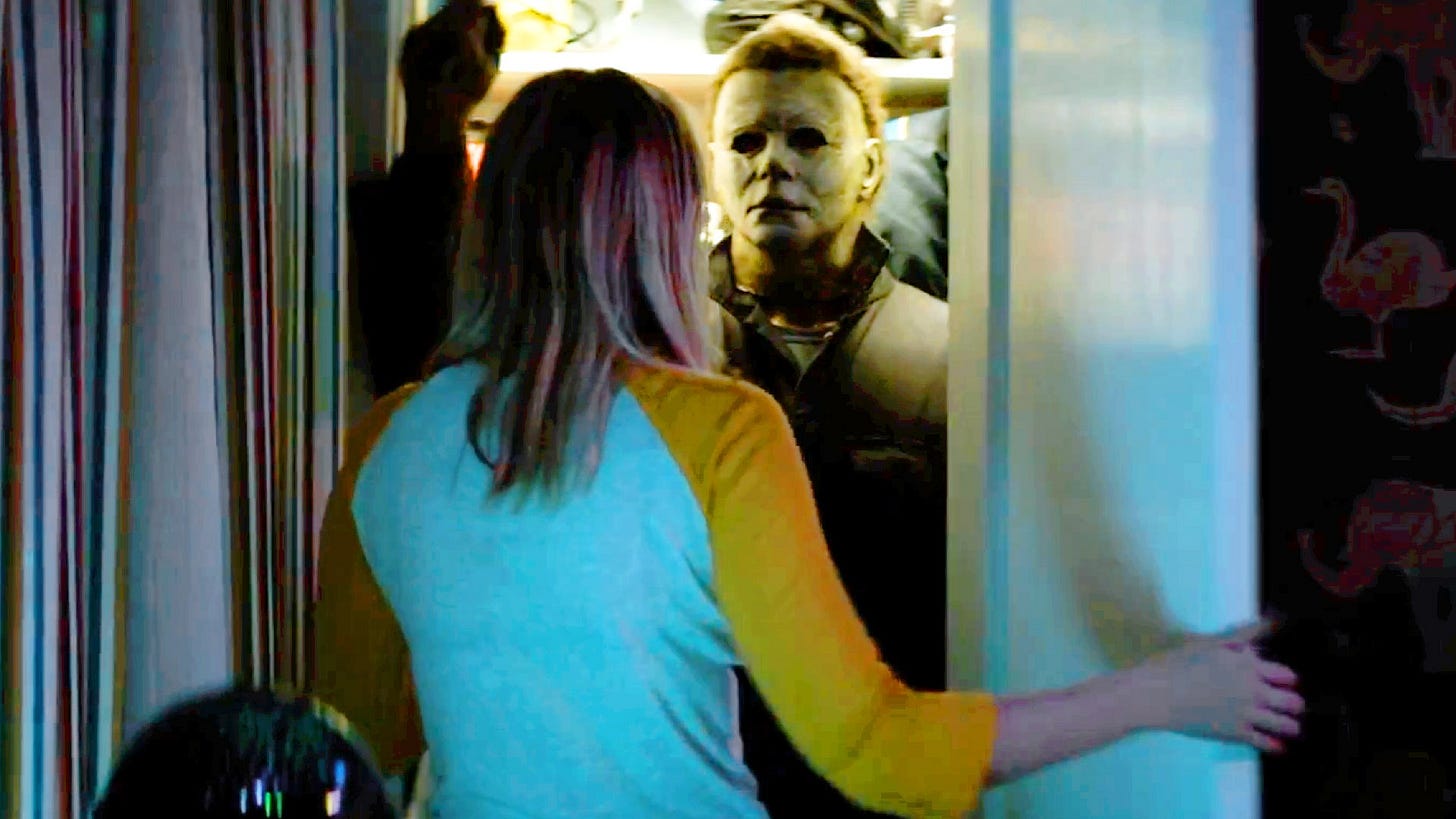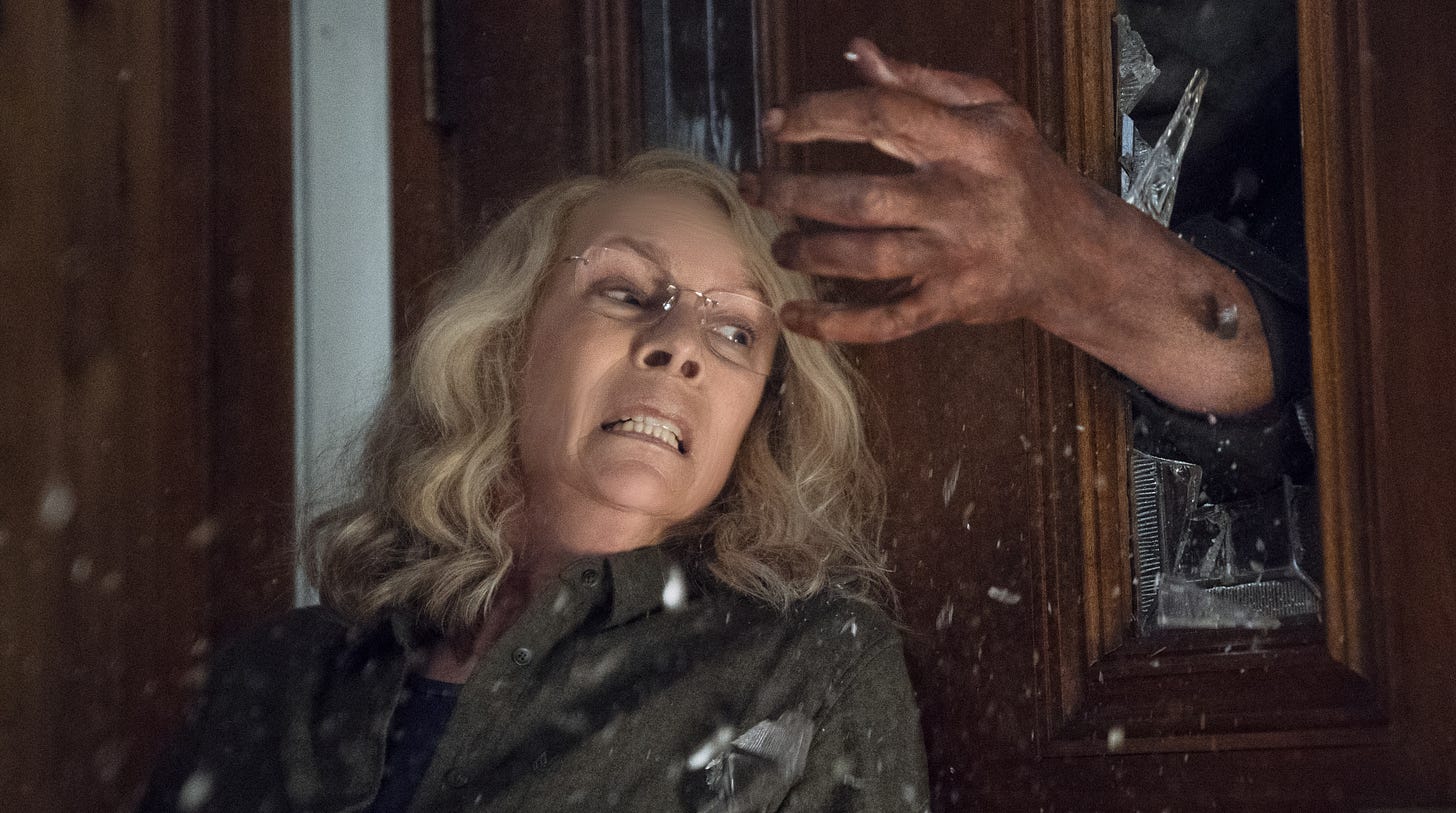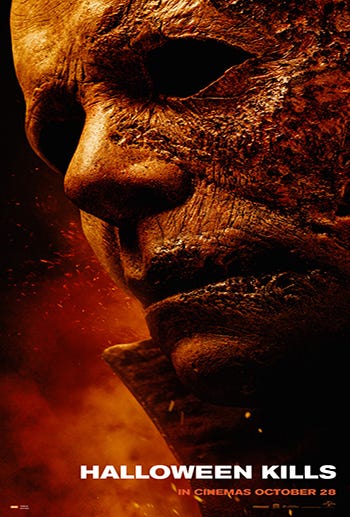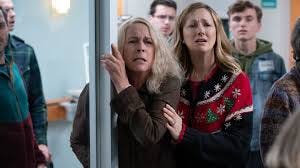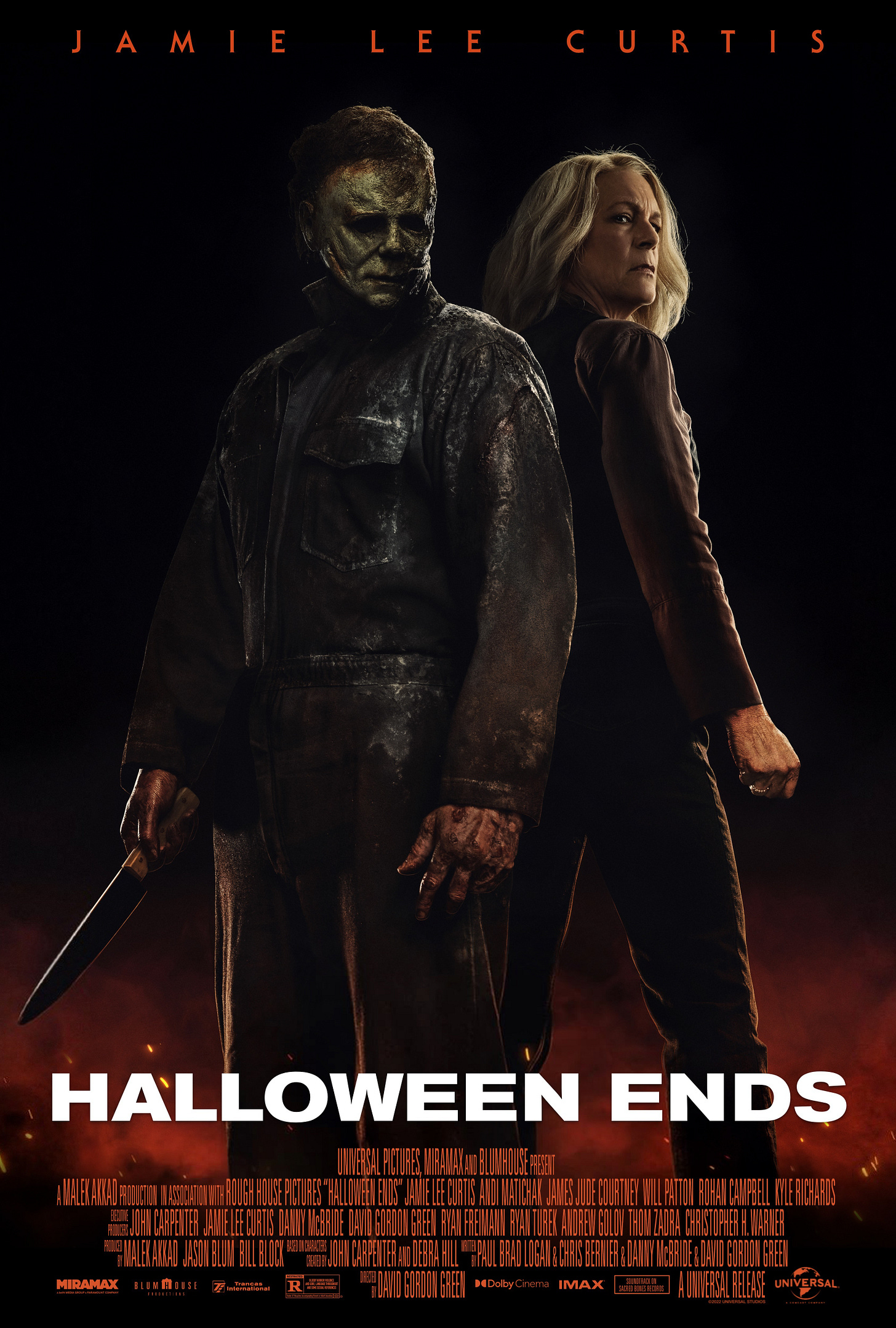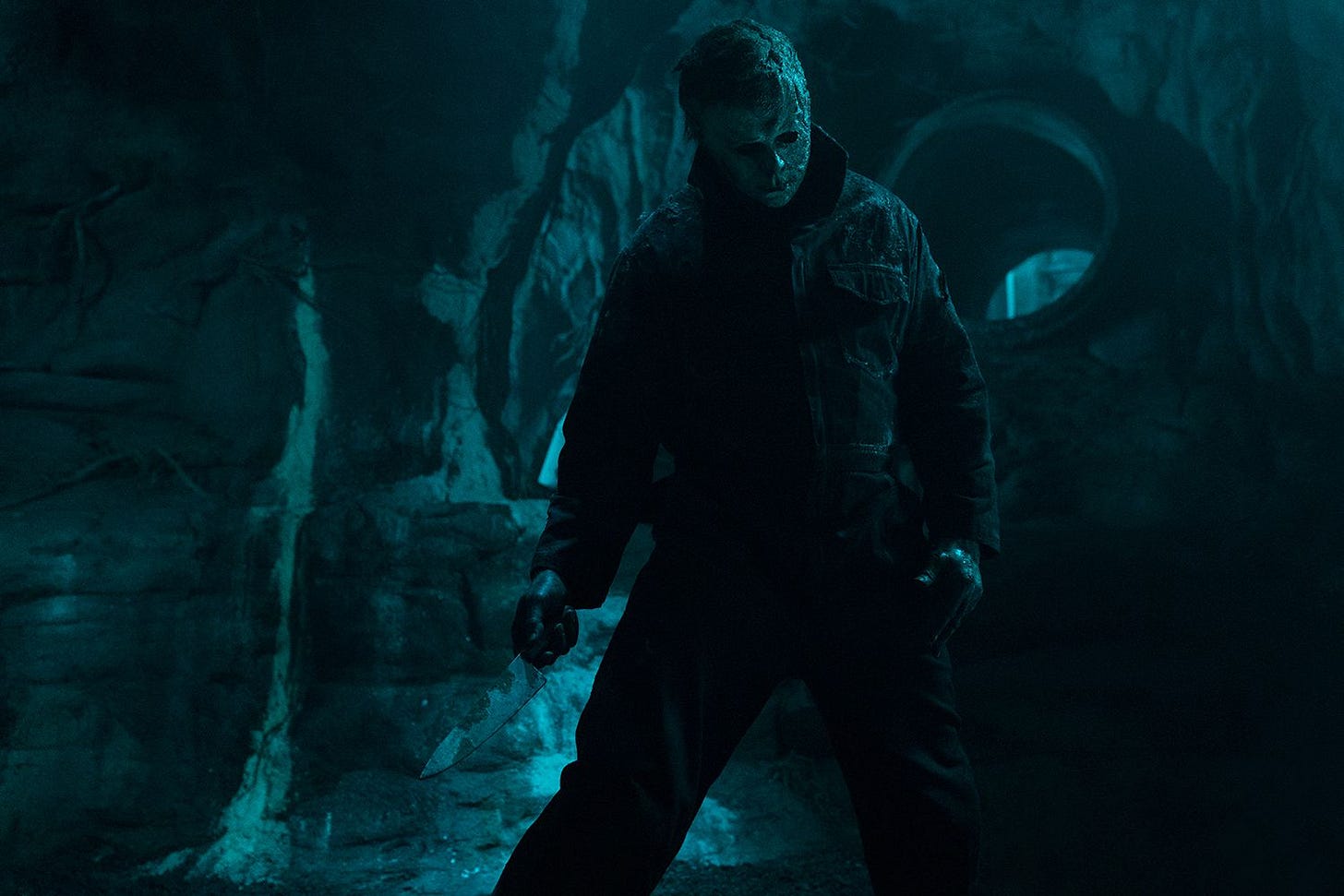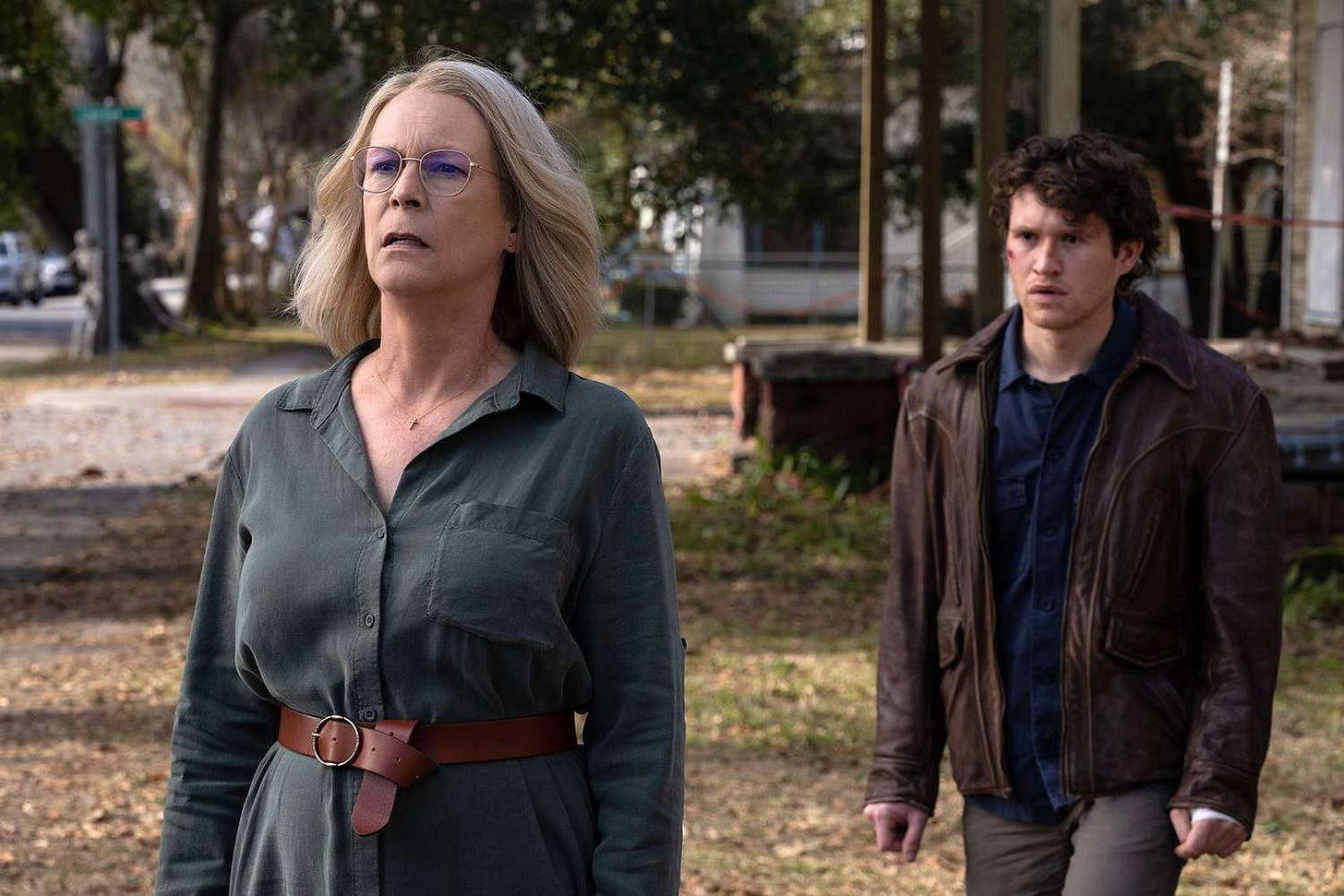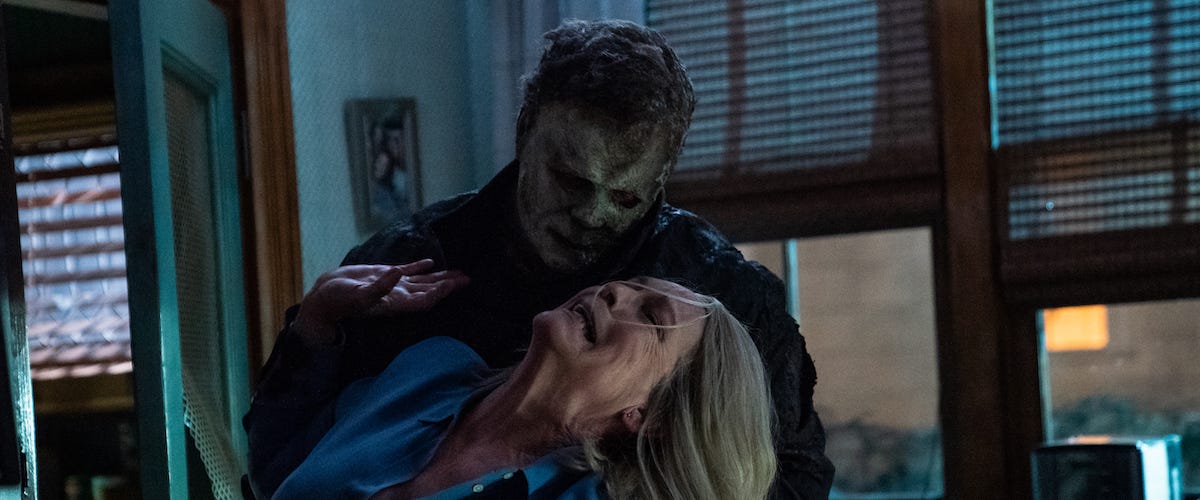I would like to try something a little different in this month’s post. Whereas I usually use the Apple Park Film Club to gush about films I love and suggest why you may like them too, this month, I want to look at three well-known, modern films that received some backlash and explain what I would do differently. I am referring to David Gordon Green’s Halloween trilogy, which, in the eyes of many, started well before the wheels had come off by the time we reached film three, Halloween Ends (2022).
John Carpenter is, without a doubt, the most influential director in my filmmaking career. Halloween (1978) was the second Carpenter film I saw (the first was Big Trouble in Little China (1986)). I was struck by how stripped-down and tense it was. I was going through a slasher phase at the time, and Sky Movies had premiered Scream (1996) and followed it up with an all-night run of Friday the 13th (1980), A Nightmare on Elm Street (1984), and Halloween. It was quite a cocktail for a young horror fan, but of the films shown Halloween was the only one to leave an indelible mark. Its focus on tension instead of gore scared me more than either, Friday the 13th or A Nightmare on Elm Street because I am inherently more scared of what I cannot see. Carpenter knew how to unsettle the audience, using repetition, pacing, and framing to draw out the tension as far as he could without snapping.
The best example is when Annie (played by Nancy Loomis) is leaving to collect her boyfriend. We already know Michael Myers has been hiding around the house where Annie is babysitting, waiting for the ideal opportunity to kill. Having dumped Lindsay Wallace (played by Kyle Richards), the girl she is babysitting, off with her friend Laurie Strode (Jamie Lee Curtis), Nancy is now alone in the house. The first time she tries to leave, she finds her car locked, reminding her that she does not have her keys. She disappears to fetch her keys, and this time, unbeknownst to Annie or us, Michael Myers (played by Nick Castle) unlocks the car and hides in the backseat. It seems like nothing, but Annie returns to the car and opens the door without using her keys. She sits behind the wheel and is ready to start the engine before realising something is wrong. It would be the perfect moment for Carpenter to release the tension built up by his use of dramatic irony, however, he gives the scene one extra beat and has Annie notice condensation on the inside of the windscreen. She wipes it away, shrugs it off, and then Myers strikes, killing Annie in an almost bloodless murder. We do not need the gore because the tension has already gotten to us.
I do not want to discuss the effectiveness of Halloween in too great of detail here, but I need to explain why I find it so effective for the sake of this article. Like Ils (2006), which I discussed in the last article, Halloween is a masterclass in tension, but that tension gets lost throughout the franchise. As the series produced sequels and grew further complicated by a requel, the franchise opted for creative and violent kills over tension. Even Halloween H20 (1998), which makes a strong attempt at heading back to the series' roots, struggles to match the tension of the original. The scene set in a dumbwaiter where Jodi Lyn O’Keefe is chased between floors by Myers manages to muster something close to the tension of the original, but it is not enough.
I like to call this flaw 'main character syndrome.' It refers to the moment when the murderer of the series becomes both the protagonist and antagonist. They remain the antagonist by default of being the villain, but they also become the audience draw. We turn up to see all the delightful ways they can murder the latest roster of teenagers. The Halloween franchise worked harder to avoid this than the Friday the 13th and Nightmare on Elm Street franchises, but the mythos created to do this are convoluted and bizarre.
By the time the franchise reached Halloween: Resurrection (2002), the series was trend-chasing and attempted to buy into the reality TV boom of the time. Busta Rhymes delivering the line ‘Trick or treat, muthafucka’ to Michael Myers before proceeding to judo the murderer into submission is one of my favourite moments of the franchise, but it is ridiculous. It was clear the series needed refreshing and Dimension Films opted for a remake.
A rising star in the horror genre at the time, Rob Zombie took a far more brutal approach when making Halloween (2007) and Halloween 2 (2009). Halloween (2007) is a relatively faithful remake of the original film, with some added backstory for the Michael Myers character (which, in my opinion, removes a lot of the elements that made the original iteration of the character so scary) and a few third act changes to tie the Laurie Strode and Michael Myers characters together. The film was a success, and Dimension rushed to get Rob Zombie back in the director’s chair for a sequel. Zombie, however, was not interested in remaking Halloween 2 (1981) and only agreed to sign on if he could make a more art-house, experimental take on the franchise. He notoriously hated working with the Weinsteins on the film, who wanted another hit like Halloween (2007). Halloween 2 (2009) was not received well. Some appreciated the more experimental approach to the film however, the consensus seems to be that many found the plot convoluted and confusing and that the more ‘indie film’ approach did not fit a slasher franchise like Halloween. If you hire Rob Zombie to make a film, you are going to get a Rob Zombie film. Regardless of my opinion of his work, Rob Zombie is an auteur. Much like John Carpenter, you know when you are watching a Rob Zombie film and you know what to expect from them. Rob Zombie delivered his take on the Halloween franchise for better or worse.
Rob Zombie’s Halloween 2 (2009) brought the franchise to a stop. No further sequels or remakes were planned for Michael Myers. However, the success of legacy sequels such as Rocky Balboa (2006), Tron Legacy (2010), and Star Wars: The Force Awakens (2015) proved there was a market for revisiting established characters years after the events of the first film or films and setting up a fresh conflict that expands upon or resolves the original storylines. Enter David Gordon Green and Danny McBride, who pitched a new Halloween film that explored the long-term effects of trauma on an individual. It is a great concept that allows for a serious and mature approach to a new entry into the Halloween franchise. This entry developed into a new trilogy of films all dealing with trauma on different levels. I would like to discuss each film individually before moving on to a discussion of the trilogy as a whole and how I would have approached it differently.
As you may expect, spoilers for the trilogy follow.
Halloween
Halloween (2018) brought a refreshing change to the franchise. By opting to eschew the rest of the films in the series (including Halloween 2), David Gordon Green and Danny McBride brought the series back to basics. They made sure the audience knew what to expect by starting the film in a prison with an already incarcerated Michael Myers and two new characters who bring us up to date. Two true crime podcasters are planning an episode where they hope to understand Michael Myers before he is locked away for good in a maximum security facility. After failing to get Michael to talk to them, the podcasters visit with Laurie Strode, who lives in constant fear that Michael will escape and come for her. We have been down this road before with Halloween: H20, but Laurie Strode in Halloween (2018) is a warrior. She is hardened, tooled up with every firearm you can imagine, and her house is rigged with traps. When Michael comes for her, she is going to be ready. At least, that is what she believes. The reality is that Laurie’s fear and preparedness is a mask for her trauma, and she still hasn’t come to terms with what happened to her forty years prior.
We then meet Laurie’s daughter Allyson (played by Andi Matichak) and Karen (played by Judy Greer. Karen was taken away from Laurie due to the survivalist circumstances under which she raised her. She has developed her mask by doing her best to keep Allyson from Laurie, even lying to keep them apart, refusing to allow the threat of Michael Myers anywhere near her family, and rejecting all of her mother’s teachings.
The first act of the movie revolves thematically around masks. Laurie has her mask in her house and the preparation for Michael’s escape, Karen has her rejection of Michael Myers and her mother, and one of the podcasters has Michael’s mask. Once he escapes, Michael seeks out his mask (and a boiler suit). The scene where Michael dispatches the podcasters lets us know what we can expect from the rest of the movie. This Halloween film is going to be violent, but violent in a way that matches the evolution of the characters, not an all-out gore-fest-like Halloween (2007).
Once Michael has escaped, the plot kicks into overdrive. We are treated to some of the best slasher sequences we have seen in a long time. David Gordon Green and Danny McBride give us characters to care about again, so when Michael is on the rampage, we are not rooting for him to murder the teens in horrible ways. We want them to survive, even the creepy ones.
Halloween (2018) has one of my favourite and one of my least favourite sequences in the franchise. There is a sequence, just after the halfway point, where Allyson and her friend are cutting through someone’s back garden. The guy makes a move on Allyson, who rejects him and leaves him to wallow in self-pity. Michael Myers arrives and uses the intermittent light and darkness caused by a motion sensor intruder light to creep up on the guy and kill him. Each time the light goes out, Michael Myers disappears and reappears in an almost (but not quite) impossible place. It is a masterwork in tension and ties the style and tone of the movie with John Carpenter’s original. The other end of this spectrum is the sequence where Dr. Sartain (played by Haluk Bilginer) attacks Officer Hawkins (played by Will Patton) so he can take Michael Myers to Laurie’s house for a final confrontation between the two. It is a plot problem that stems from the first act (and they always say that third-act problems are first-act problems). By positioning Laurie in a house out of town, there is no way to get Michael there while maintaining the stance that Michael is not seeking out Laurie especially. The Podcasters and the Doctor believe that Michael seeks a resolution with Laurie and wants her to speak to him. Green and McBride make the sensible decision to avoid this and have Michael just being a psychopath, but this means they have to find a way to get Michael out of town and into the forest to face Laurie, and the Doctor is the way they do this. It does not work for me, and I am sure with a bit more thought, they could have come up with something better.
The final confrontation fulfils its promise, with Green revisiting iconic scenarios from the original film but reversing or subverting our expectations. The confrontation leaves Michael burning in a trap designed by Laurie years in advance. It brings Laurie’s trauma to a close. Karen is reunited with her mother, removing her mask, and Michael is dying.
The film works well. The close collaboration with Carpenter means Green recreates the look and feel of the original. You could play them one after the other, and it would feel seamless.
Halloween Kills
Halloween (2018) was a hit. Making just under $260,000,000 on a $10,000,000 budget was too much to ignore, so Blumhouse, Green, and McBride naturally discussed the possibility of sequels. Whenever a successful film morphs into a trilogy, the filmmakers always say that a trilogy was always the intention, and that was the case here. Whether it is true or not is between the key players, but me? I don't believe it. I believe, Green and McBride saw an opportunity to expand their ideas and have fun making slasher films, and I would make the same choice. Halloween Kills (2021) and Halloween Ends (2022) were greenlit and shot almost back to back (the COVID-19 pandemic slowed down the end of production and delayed the release of both films).
Halloween Kills picks up exactly where Halloween (2018) left off. We join Allyson’s boyfriend, Cam (played by Dylan Arnold), as he stumbles upon a wounded Officer Hawkins. Hawkins, having failed to kill Michael in the first film, is suffering from his trauma of twice having the opportunity to kill Michael and twice failing to do so. Through a flashback, we learn that during the initial slaughter of 1978, Hawkins had tried to shoot Michael but had shot and killed his partner instead (played by Jim Cummings), and the police had covered it up and blamed Michael. This setup leads us to meet the other new/returning cast members. Tommy Doyle (played by Antony Michael Hall). Tommy’s bully in the first film, Lonnie (played by Robert Longstreet), Lindsey (played once again by Kyle Richards), and Marion (played by Nancy Stephens, who also returned for Halloween: H20 only to be dispatched in the first ten minutes).
Halloween Kills seeks to examine the effects of a traumatic event on an entire town. The return of Michael Myers sparks a need to face him head-on in Tommy, Lonnie, Lindsey, and Marion, who also rope the rest of the town into a frenzy. Tommy heads to the hospital in a bid to recruit Laurie, who believes Michael is still coming for her. As a result, Tommy stays with Laurie and Karen. Allyson opts to join Cameron and Lonnie to track down her father’s murderer.
We have three groups, each representing different aspects of Trauma within the town. We have Lindsey and Marion, who are actively hunting down Michael Myers and trying to extinguish the source of their trauma whilst dragging two new characters with them. Lonnie, Cameron, and Allyson, but their trauma represents a fresh trauma. One that has not had time to fester. Lonnie is the exception. He was not attacked by Michael Myers. He only came face to face with him. Finally, we have Laurie, Karen, and Tommy at the hospital, surrounded by a disproportionate amount of townspeople, all looking for their friends and family. Their trauma is different. They are making it about them, with Tommy trying to control it and Laurie regressing into her trauma with the belief Michael is coming for her.
Amongst all of this, there is a subplot surrounding a couple now living in the Myers house. Big John (played by Scott MacArthur) and Little John (Michael McDonald) have moved in and modernised the Myers house, erasing any history of Michael and his crimes. The opening flashback sets up that Michael is trying to get home, that he has an almost supernatural connection to it that draws him there. This subplot does not reconcile with the rest of the film as much. There is already a lot of jumping between plot threads, but the other threads feel connected by a shared theme. Whenever we cut to the Myers house it risks taking us out of the film because this theme is not connected to the others.
Fun fact - Michael McDonald played the security guard who was run over by the steamroller in Austin Powers, meaning he has been killed by both Mike Myers and Michael Myers.
Halloween Kills biggest problem, in my opinion, is that it tries to spin too many plates at once. We jump between four different plot threads, each trying to make a different point, and it does not coalesce satisfyingly. It is part of the problem when you want to tackle an idea on a larger scale. Halloween (2018) worked because it was straightforward and contained, except for the Doctor sequence I discussed above. Halloween Kills does not have that benefit because we are looking at the whole town. There is a sequence where one of the other escaped patients from the asylum goes to the hospital for help. The crowd, egged on by Tommy, chases the patient through the hospital until they corner him. The patient ultimately throws himself out of the window in a last-ditch bid to escape. Tommy’s been riling the crowd up the entire evening, chanting ‘Evil dies tonight!’ alongside them, whipping them into a frenzy. They are rabid in their pursuit of the patient, and despite the best efforts of Karen, the Sheriff, and even Laurie to stop them, they are an uncontrollable mob. This should have been a moment to dig into how people react in a panic (watching the film just after the Southport riots in the UK meant this sequence hit a lot harder than it did the first time around) to misinformation, but the film squanders it. Instead, former Sheriff Brackett (played again by Charles Cyphers) claims that Michael is turning them into monsters. But they did this, and he had his hand in whipping up the crowd as much as Tommy did. If anyone is turning the town into monsters, it is them. There is no moment of self-reflection or lucidity. I think the film needs one to make the point it is trying to make.
It also suffers from a lack of protagonist. With Laurie stuck in the hospital and the story jumping between the different groups hunting Michael and the Myers house, there is no one for us to root for. The closest we get is Karen, who becomes the protective mother at the end when she confronts Michael to save Allyson.
Halloween Kills' ending caused much contention amongst audiences. Lonnie determines Michael is heading home, so they follow him to the Myers house. Michael quickly kills both Lonnie and Cameron and wounds Allyson. Karen arrives and steals his mask, switching his focus. It is a nice throwback to the mask themes in the first film, but Karen’s whole defenceless woman rant rings hollow when you consider she just impaled Michael Myers with a rake. Despite this, with his mask gone, Karen leads Michael into a trap one street over, where the hospital crowd, led by Tommy, lies in wait for him. Halloween (2018) went to great lengths to remove all the supernatural, immortal monster elements from the Michael Myers legacy and present him as a man. There is a scene in Halloween Kills where Hawkins describes him as a six-year-old boy in a grown man’s body. The ending of Halloween Kills makes this null and void. The crowd batters Michael with a range of blunt instruments and shoots him six times directly in the chest, and he gets up. He gets up and slaughters them all in the street, returns home, and kills Karen whilst Police and medical crews wait downstairs. Then he disappears.
Halloween Ends
Set four years after Halloween Kills, Halloween Ends is the most divisive film of the trilogy. It is a film with big ideas and feels very different from the previous two entries in the trilogy. The deviation from the traditional Michael Myers slash-and-kill format took a lot of people by surprise, but as an avid fan of the whole franchise, I knew what to expect going in. The film opens with the same blue font that opens Halloween 3: Season of the Witch (1982). As soon as I saw that font on the screen, I knew Halloween Ends would be different. It is a nice little nod to the past that only long-time fans would recognise.
Halloween Ends still focuses on traumas, but it is about what happens when we leave our traumas unresolved. It posits that Haddonfield has a symbiotic relationship with the traumas caused by Michael Myers. When he disappeared at the end of Halloween Kills, the town found itself with a hole in its soul. People suffered from depression, committed suicide, and a young child died whilst under the care of his babysitter, Corey (played by Rohan Campbell). Whilst the death of the young child was not Corey’s fault, the town of Haddonfield blamed him for it. He became their new Michael Myers, shunned by the town's residents whilst his over-protective mother refuses to let him take risks.
Laurie has seized the opportunity to move on from her traumas, writing a book about the confrontation with Michael Myers and its effect on her life. Allyson, on the other hand, struggles with life in Haddonfield post-Michael. The death of her parents at the hands of the monster that almost killed her has driven her to depression. She sees no way out of her situation, and the once proud honours student is now an assistant nurse in a small medical facility run by a sleazy Doctor.
It should be fate that two young people at such low points in their lives would find each other, and after Corey has a chance encounter with Laurie, that is exactly what happens. In a post-Michael Haddonfield, love blooms between two misfits. After Allyson invites Corey to a party, he gets spotted by the mother of the boy who died and is forced out of the event.
It turns out that post-Michael Haddonfield is not as post-Michael as many believed. After an altercation with some thugs, Corey is thrown from a bridge and dragged into the sewers, where he comes face to face with Michael Myers, still severely wounded after the events of Halloween Kills. This scene is largely misunderstood. When Corey comes face to face with Michael, Michael places his hand on Corey’s shoulder and looks into his eyes. We see a flashback of the events of the opening sequence and Michael pushes Corey away and lets him go. People have read this as Michael transferring the evil inside him to Corey, a reading I believe is wrong. Instead, I would posit that this is Michael recognising that he and Corey are the same. They are both outcasts in their community, they have both killed, and they are both the source of Haddonfield’s traumas. Michael does not transfer his evil; he sees a kindred spirit. There is a key line in the film when Laurie goes to visit Corey’s mother. Corey’s mother blames Laurie for Corey’s situation, telling her that ‘when your boogeyman went away, this town needed a new one, and it chose my son.’ This line and the scene where Michael first meets Corey both sum up what the film is about. If you do not deal with your trauma it will manifest in a new form further down the line. That new form is Corey, and not long after the meeting with Michael, Laurie sees Corey, and she sees what the rest of the town sees.
The rest of the film plays out as Corey tries to balance his burgeoning relationship with Allyson and the revenge he seeks out on those who have wronged him. He develops an almost symbiotic relationship with Michael, providing victims for the recovering serial killer, who seems to grow stronger with each kill. Instead of confronting the trauma, Corey feeds it, and as he feeds it, it becomes ever-present in life. Allyson too, is addicted to the trauma, unable to confront it. She sees Corey as her way out of Haddonfield and she won’t let him go, even if it means turning against Laurie, who has cared for her since her parents were murdered.
It is a layered film that strays far from the slasher formula associated with the Halloween franchise. The film was marketed as the showdown between Laurie and Michael, and whilst the film delivers that confrontation (and it is suitably brutal), it is not what the film is about. People didn’t get the film they were expecting, but David Gordon Green did try to tell them that with the font on the opening credits.
The Trilogy as a Whole
So, does the trilogy work as a whole? And what could have been done differently to make it feel more cohesive? It is important to preface this conclusive part by saying that I do not want to imply that I know better than the filmmakers. However, being a creative and a storyteller, I cannot help but look at things and think about how I might do them.
To start, I think David Gordon Green’s Halloween trilogy works well. I enjoy all three films, and I think they work as a cohesive story as presented. That said I think Halloween Ends would work better as the second film in the trilogy. Allow me to explain.
We get to the end of Halloween (2018), and Laurie has locked Michael in the basement of the burning house. Cameron finds Hawkins and calls the emergency services whilst Laurie, Karen, and Allyson are taken to the hospital. The fire services arrive at Laurie’s house. Michael escapes, killing them all in the process. He then disappears into the woods, wounded from the fight at the end of Halloween. Michael is gone for years, during which time Corey accidentally kills the young boy in his care and is shunned by Haddonfield. The events of Halloween Ends then play out, with some minor adjustments to include Karen until the confrontation between Laurie and Michael. The conflict plays out when Michael comes to retrieve his mask from Corey, but Laurie is wounded and Michael escapes into Haddonfield. The events of Halloween Kills play out similarly, but Laurie has a more active role as the protagonist. After being attacked in his home by Karen, Michael is assaulted in the street by the crowd and then carried by car to the workshop, where they crush him in the heavy machinery as per the end of Halloween Ends.
My approach may have given audiences the conclusion they expected from the franchise. I suppose the real question is, do we always want to get what we expect?
I have quite enjoyed this exercise in speculation and will bring it back for future articles on the blog. If you have stuck with me this far, thank you, your readership is greatly appreciated. Don't forget to share the Substack with anyone who may enjoy it.


